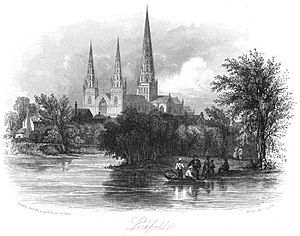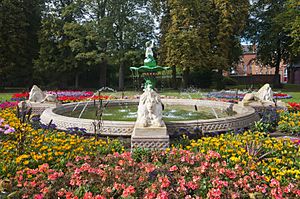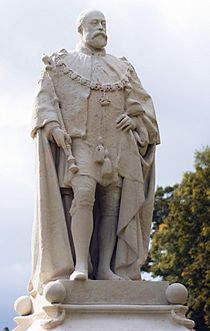Beacon Park facts for kids
Quick facts for kids Beacon Park |
|
|---|---|
Museum Gardens with the spires of Lichfield Cathedral in the background.
|
|
| Type | Public park |
| Location | Lichfield, Staffordshire |
| Area | 69 acres (28 ha) |
| Elevation | 80m AMSL |
| Created | 1859 |
| Operated by | Lichfield District Council |
| Open | All year |
| Awards | BALI Grand Award (2012) |
Beacon Park is a large public park right in the middle of Lichfield, a city in Staffordshire, United Kingdom. It first opened in 1859 with the Museum Gardens, which were built next to the new Free Museum and Library.
Over time, the park grew bigger and bigger. Today, it covers about 69 acres (28 hectares) of open green space in the city centre. You can find it in the northwest part of Lichfield, just across the road from the Garden of Remembrance and near the Cathedral.
Most of the park used to be wet, marshy land with a big lake where the Museum Gardens are now. In the early 1800s, the land was drained. The Museum Gardens area was raised using mud from Minster Pool. The large northern part of the park used to be the gardens of a house called Beacon House. This land became part of the park when its owner, Colonel Swinfen Broun, gave it to the city after he passed away.
Beacon Park is a super fun place with lots of things to do! It has an 18-hole golf course, football pitches, tennis courts, and bowling greens. The park also hosts many cool events all year, like the Lichfield Bower and The Lichfield Festival. You'll also find several important statues here, including a big bronze one of Captain Smith from the RMS Titanic.
Contents
Park History
How the Park Started
The land where Beacon Park now stands was once low, wet grassland next to a stream called Leamonsley Brook. The Museum Gardens and Recreation Grounds used to be a big pond called Bishops Fish Pool. This pond was created in the 1300s when a road was built on Beacon Street, separating it from Minster Pool. The marshy land around Bishops Fish Pool was known as 'The Moggs' from the 1400s, and later 'Swan Moggs'.
From the early 1300s, Swans were kept on Bishops Fish Pool by the Bishops of Lichfield. They even built special pens and nesting spots for them! Later, the city of Lichfield took over owning the swans. You can still see a hint of this history in street names like Swan Road and Swan Mews nearby.
Before it became a park, most of this land was used for farming from at least the 1200s to the 1800s. You can still see signs of this in street names like Townfields, south of the park, and Shaw Lane, which was once a field called Shaw in 1336.
Changes in the 1800s
In the early 1800s, the city needed more water. So, they started moving water from 'Swan Moggs' into pipes underground. The land was then raised using mud from Minster Pool. This helped turn the marshy area into the beautiful gardens we see today. The city of Lichfield developed these gardens, with help from the Conduit Lands Trust.
The Museum Gardens officially opened in 1859. They were designed to go with the new Italian-style Free Library and Museum. The Recreation Grounds, a smaller area between the Museum Gardens and the wider park, opened in 1891. A large fountain was added to the centre of the Museum Gardens in 1871. There was also a bandstand, where musicians would play, at the southern end of the Museum Gardens.
The larger part of Beacon Park grew along with Beacon House, a big home built in 1800. Over the 1800s, as different people owned the house, they added more gardens and parkland. In 1826, an owner named Richard Hinckley made the house bigger and improved the landscape. He even dug two fish ponds and built a long, fancy path leading to the house. In 1880, Samuel Lipscomb Seckham bought Beacon House and its 32-acre (13-hectare) estate. He made the parkland even bigger, covering 100 acres (40 hectares), and added a walking path near the house, connecting it to the ponds.
The Park in the 1900s
Statues of King Edward VII and Captain Edward Smith were put up in the Museum Gardens in 1908 and 1914. During the First World War, Beacon House was sold to the army. After the war, a cannon from the Crimean War and a German gun from the First World War were placed in the Museum Gardens. But they were later taken away for scrap metal during the next war.
After the First World War, the park was a place for big celebrations. The Recreation Grounds were used for sports, and the Museum Gardens for dancing. The Garden of Remembrance was created across Beacon Street in 1920. A public toilet building, partly made from old materials from a nearby Friary, was built in 1930.
Beacon House was used by the army during the Second World War. It was later taken down by the City Council in 1964. The land where Beacon House stood is now a housing estate with streets named after previous owners, like Swinfen Broun Road and Seckham Road. Colonel Swinfen Broun gave 12 acres (4.9 hectares) of his land to the park in 1943. After the land from Beacon House was added between 1943 and 1964, Beacon Park became the size it is today.
Throughout the rest of the 1900s, many fun facilities were added. Football pitches were created in 1947. A second bowling green was added in 1962, joining the one built in 1922. In 1972, the two fish ponds were reshaped into the single Beacon Pool we see today. The golf course was built and opened in 1973.
Beacon Park Today
In 2009, Beacon Park, along with Minster Pool and Walk and the Garden of Remembrance, received a huge grant of £3.9 million from the Heritage Lottery Fund and the Big Lottery Fund. This money helped transform the park! Work started in 2010 and finished in 2012. They built a new café, a refreshment kiosk, a bowls and education building, and new toilets. They also made the play areas much better for kids of all ages.
Important statues, railings, and the fountain were also carefully fixed up. In the Museum Gardens, the bowling green was moved to the Recreation Grounds. In its old spot, beautiful flower beds were planted to bring back the Victorian look of the gardens.
Statues and Monuments

Beacon Park is home to several interesting statues and monuments, each with its own story.
- Plaque of Martyrs – This stone plaque used to be the official seal for the city of Lichfield. It shows a disputed story of 999 Christian martyrs who were said to be killed by the Romans in Lichfield in 288 CE. The plaque was on the front of the Guildhall until 1744. It was put in storage and then moved to a rockery in the Museum Gardens in 1864. It fell into disrepair until 2010 when it was fixed and placed on a stand in the Recreation Grounds. You can also see this seal on the railway bridge at St John's Street.
- Chancellor Law's Fountain – This beautiful fountain was revealed in May 1871. It was made by Turner and Allen of London. The lions are made of stone, and the main figure is sculpted iron. The fountain was a gift from James Thomas Law, who was an important person in the church and gave a lot to the city. He also gave the statue of Samuel Johnson in the market square. This fountain is right in the middle of the Museum Gardens. In 2011, it was restored with money from the Lichfield Conduit Lands Trust.
- King Edward VII – This statue was unveiled in September 1908. It was made by a local stonemason, George Lowther. The base is made of Hoptonwood stone, and the king's figure is made from Portland stone. Edward is shown wearing his full coronation robes and holding a sceptre. The city's coat of arms is on the front of the base. The statue was put up while Edward was still king to show the city's loyalty to him. It was rededicated on April 24, 2013, by The Princess Royal.
- Captain Edward Smith – Unveiled in July 1914, this statue is at the western end of the Museum Gardens. It was sculpted by Kathleen Scott, who was married to the famous Antarctic explorer Robert Scott. The base is made of Cornish granite, and the figure is bronze. This statue is a memorial to the captain of the RMS Titanic, which sadly sank on April 15, 1912. Captain Smith was from Hanley, Staffordshire. Lichfield was chosen for the monument because he was a Staffordshire man, and Lichfield was the main city of the diocese. The statue originally cost £740, raised by people locally and nationally. In 2010, as part of the 'Parks for People' project, the statue was cleaned and restored for £16,000.
- Colonel Swinfen Broun – This memorial was unveiled in September 1972. It's a 1.9-meter (6.2-foot) high sandstone brick with two bronze plaques. In 1948, Lichfield lost a very generous person, Colonel Swinfen Broun. He had paid a lot for Victoria Hospital, given the Guildhall its clock, and donated 12 acres (4.9 hectares) of land to Beacon Park in 1943. In his will, he also left half of his estate at Swinfen Hall to Lichfield Cathedral and the other half to the Lichfield Corporation. A memorial was set up on the west side of Beacon Pool after he passed away to remember his contributions to the city.
- Erasmus Darwin – Unveiled on December 12, 2012, this is a 2.3-meter (7.5-foot) high bronze statue of Erasmus Darwin, sculpted by Peter Walker. The statue is located near the Bird Street entrance to the Museum Gardens.
Fun Things to Do
Beacon Park has many sports facilities for everyone to enjoy! You'll find flat and crown bowling greens in the recreation grounds. The Lichfield Museum Bowling Club has been playing here since 1922 and is one of the oldest bowling clubs in the country. There are also four tennis courts, six football pitches (in season), a basketball court, a cricket pitch (in season), and an 18-hole public golf course.
Besides sports, there are other fun things to do! You can play crazy golf, or visit the playgrounds for younger and older children. During the summer, you can even go canoeing on Beacon Pool, ride donkeys, play giant board games, or jump on a bouncy castle!
Two new places to eat opened in the park in May 2012. The Lakeside Bistro is near Beacon Pool, and Chandlers Café is at the Bird Street entrance. These were built as part of the big £3.9 million park improvement project.
Events and Entertainment
Beacon Park is a popular spot for many exciting events throughout the year. The Lichfield bower and the Lichfield Festival hold events in the park every summer.
'Cars in the Park' is a super popular event that happens every year at the end of June. It started in 1997 and now shows off more than 1,000 old and new cars! In 2011, 62 different car clubs took part. 'Lichfield Proms in the Park' is an outdoor classical music concert that takes place every year on the first Saturday of September. A big top Circus also visits the park every spring.
Images for kids








